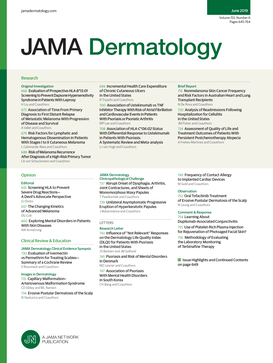Polaskey MT, Chang CH, Daftary K, Fakhraie S, Miller CH, Chovatiya R. JAMA Dermatol. 2024 Aug 1;160(8):846-855. doi: 10.1001/jamadermatol.2024.1987.
Key Points
Question What is the global prevalence of seborrheic dermatitis, and how do demographic variations affect its prevalence?
Findings In this meta-analysis of 121 studies including 1 260 163 individuals, the pooled global prevalence of seborrheic dermatitis was 4.38%, with significant variations across age groups and geographical regions.
Meaning This study highlights the global prevalence of seborrheic dermatitis and its significant variations across demographics and geographical regions.
Abstract
Importance Seborrheic dermatitis is a prevalent chronic inflammatory skin disease, yet its global prevalence, pathogenesis, and epidemiology remain inadequately defined.
Objective To provide a detailed estimation of the global prevalence of seborrheic dermatitis, analyze demographic variations, and explore differences in various settings.
Data Sources Embase, PubMed, Scopus, and Cochrane Database of Systematic Reviews were searched from inception through October 2023.
Study Selection Original investigations on seborrheic dermatitis prevalence were included after duplicate screening of titles, abstracts, and full articles, including only studies with clinician-diagnosed cases.
Data Extraction and Synthesis Following PRISMA guidelines, data were extracted and quality was assessed independently by multiple reviewers. A random-effects model using restricted maximum likelihood was used for meta-analysis and subgroup analyses.
Main Outcome and Measure The primary outcome was the pooled estimate of global seborrheic dermatitis prevalence.
Results From 1574 identified articles, 121 studies were included, encompassing 1 260 163 individuals and revealing a pooled global seborrheic dermatitis prevalence of 4.38% (95% CI, 3.58%-5.17%), with significant heterogeneity (I2 = 99.94%). Subgroup analyses showed variations by age, with a higher prevalence in adults (5.64% [95% CI, 4.01%-7.27%]) compared to children (3.70% [95% CI, 2.69%-4.80%]) and neonates (0.23% [95% CI, 0.04%-0.43%]). Geographic analyses indicated variability, with the highest prevalence in South Africa (8.82% [95% CI, 3.00%-14.64%]) and the lowest in India (2.62% [95% CI, 1.33%-3.92%]).
Conclusions and Relevance This comprehensive meta-analysis provides a detailed estimation of the global prevalence of seborrheic dermatitis, highlighting significant variability across different demographics and settings.

No comments:
Post a Comment